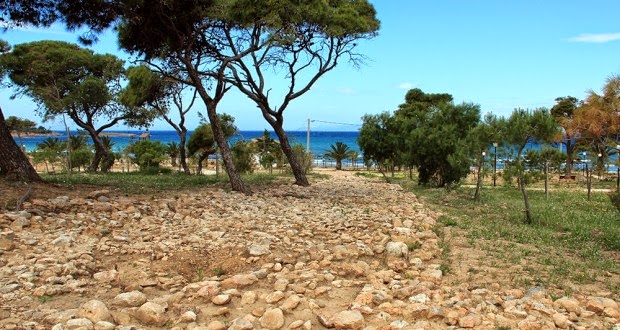The Ministry of Culture announced on Monday that a 300-meter section of an ancient carriage way dated to the 4th century BC was excavated by archaeologists at Megalo Kavouri beach in the southern suburb of Vouliagmeni. The pathway is believed to have linked the ancient demos of Aixonidai Alon with the beach and is connected to a ggreater road network that included a road linking Athens with Sounion – the southernmost tip of the Attica peninsula. There was also an ancient road from the coast of Faliro to Voula.
Protothema reports that the foundations of a rectangular building with a floor that resembles the road were found in the area, leading archeologists to believe it was constructed at the same time as the road. Evidence on pottery and coins shows that it the area was in use throughout the 4th century BC. Small stones placed close to each other marked the pavement with variations in width from 1.90 meters to 6.10 meters. Retaining walls on either side helped keep the pavement over the soft and sandy area smooth and stable.
Excavations began within a general NSRF-funded project to improve the area of Megalo Kavouri, and were later funded by Greek shipowner Athanassios Martinos, whose support allowed the completion of an archaeological park at Megalo Kavouri beach. Excavations are under the ministry's Ephorate of Antiquities of Western Attica, Piraeus and the Islands (formerly the 26th Ephorate of Prehistoric and Classical Antiquities).
Protothema reports that the foundations of a rectangular building with a floor that resembles the road were found in the area, leading archeologists to believe it was constructed at the same time as the road. Evidence on pottery and coins shows that it the area was in use throughout the 4th century BC. Small stones placed close to each other marked the pavement with variations in width from 1.90 meters to 6.10 meters. Retaining walls on either side helped keep the pavement over the soft and sandy area smooth and stable.
Excavations began within a general NSRF-funded project to improve the area of Megalo Kavouri, and were later funded by Greek shipowner Athanassios Martinos, whose support allowed the completion of an archaeological park at Megalo Kavouri beach. Excavations are under the ministry's Ephorate of Antiquities of Western Attica, Piraeus and the Islands (formerly the 26th Ephorate of Prehistoric and Classical Antiquities).


No comments:
Post a Comment